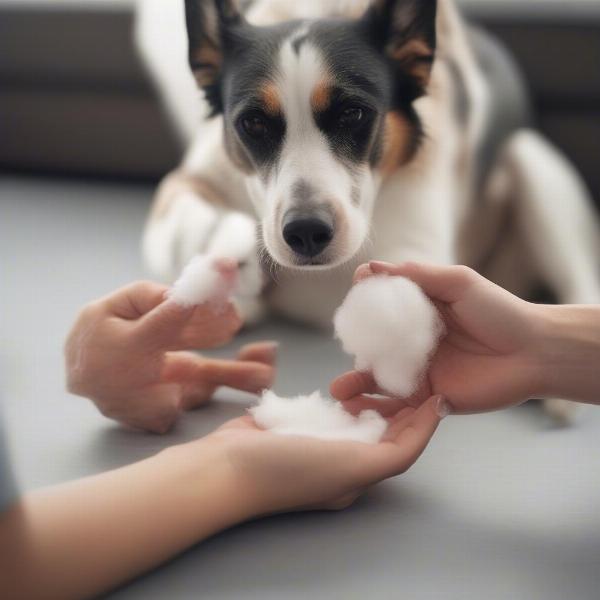A dog cut foot can be a distressing experience for both the dog and the owner. Whether it’s a minor scrape or a deeper laceration, prompt and proper care is essential to prevent infection and ensure a speedy recovery. This guide will cover everything you need to know about treating and preventing cuts on your dog’s paws, from identifying the severity of the injury to providing appropriate first aid and aftercare.
Understanding the Severity of a Dog Cut Foot
The first step in treating a dog cut foot is to assess the severity of the injury. A minor scrape may only require cleaning and monitoring, while a deep cut or puncture wound may need veterinary attention. Look for signs of bleeding, swelling, lameness, and foreign objects lodged in the wound. If the bleeding is profuse, apply direct pressure with a clean cloth and seek immediate veterinary care.
Providing First Aid for a Dog Cut Foot
If the cut is minor, you can administer first aid at home. Start by gently clipping the hair around the wound to prevent further contamination and allow for better visibility. Clean the wound thoroughly with warm water and a mild antiseptic solution. Avoid using hydrogen peroxide, as it can damage healthy tissue. Pat the area dry with a clean towel.
 Cleaning a Dog Paw Wound
Cleaning a Dog Paw Wound
Veterinary Care for a Dog Cut Paw
If the cut is deep, heavily contaminated, or shows signs of infection (such as redness, swelling, pus, or a foul odor), consult a veterinarian immediately. They may need to clean and debride the wound, suture it closed, or prescribe antibiotics to prevent infection. In some cases, pain medication may also be necessary.
Preventing Dog Cut Feet
Taking preventative measures can significantly reduce the risk of your dog cutting their paws. Regularly check your dog’s paws for any cuts, abrasions, or foreign objects. Keep your dog’s nails trimmed to prevent them from catching and tearing. When walking your dog, avoid areas with sharp rocks, broken glass, or other debris. Consider using dog booties, especially in hazardous terrain or during extreme weather conditions.
Conclusion
A dog cut foot requires prompt attention and care to prevent complications. By understanding how to assess the severity of the injury, provide appropriate first aid, and take preventative measures, you can help your furry friend recover quickly and safely. Remember to always consult a veterinarian if you have any concerns about your dog’s paw injury.
FAQ
- How can I tell if my dog’s cut foot is infected? Signs of infection include redness, swelling, pus, a foul odor, and increased pain.
- Can I use Neosporin on my dog’s cut paw? While small amounts of plain Neosporin are generally considered safe, it’s best to consult with your veterinarian before applying any topical medications.
- How long does it take for a dog’s cut paw to heal? Healing time varies depending on the severity of the injury, but minor cuts typically heal within a week or two.
- What can I do to prevent my dog from licking their cut paw? Use an Elizabethan collar or a paw bandage to prevent licking and further injury.
- When should I take my dog to the vet for a cut paw? If the cut is deep, bleeding profusely, shows signs of infection, or if you are unsure about the severity, seek veterinary care immediately.
- Are there any home remedies for treating a dog cut paw? While some home remedies like soaking the paw in Epsom salts can be beneficial, it’s always best to consult with your veterinarian before trying any home treatments.
- Can a dog cut paw lead to serious complications? Untreated cuts can lead to infections, which can spread to the bone and other tissues.
Related Articles
About ILM Dog
ILM Dog is your trusted international source for comprehensive information on dog care and wellbeing. From breed selection and health to training, nutrition, and grooming, we offer expert advice for dog owners of all experience levels. Our articles cover a wide range of topics including dog apparel, kennels, and essential gear. For personalized support or specific questions, reach out to our team of experts. Email: [email protected], Phone: +44 20-3965-8624.